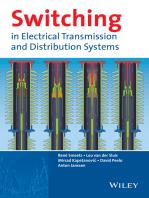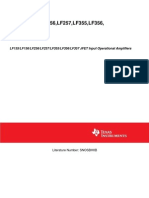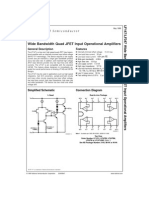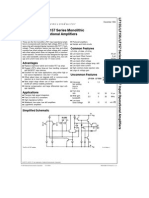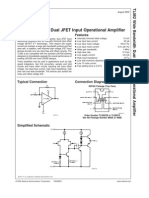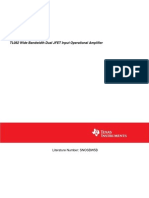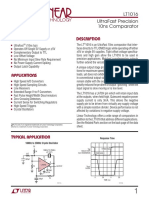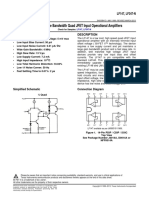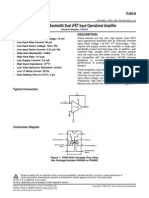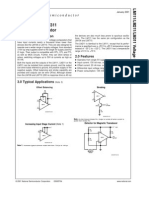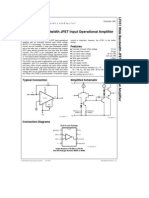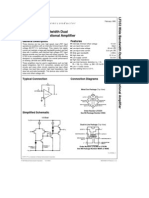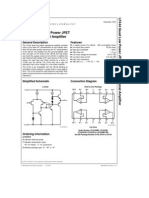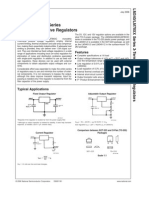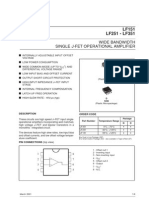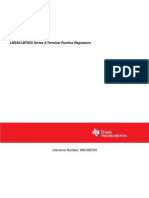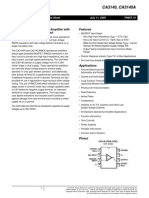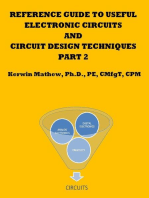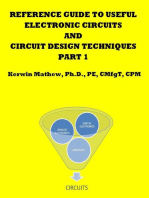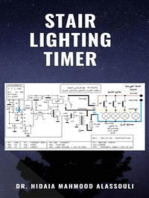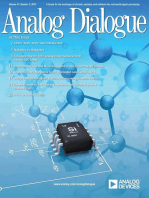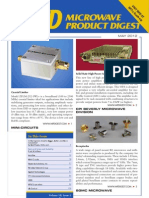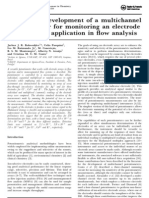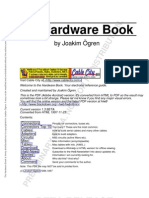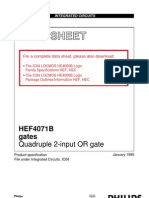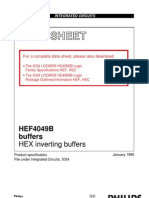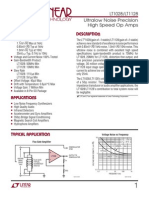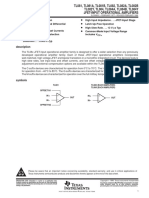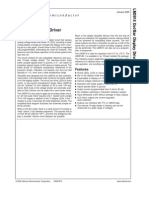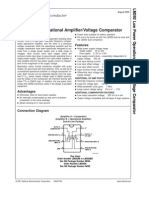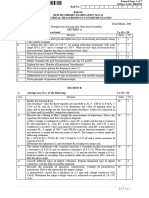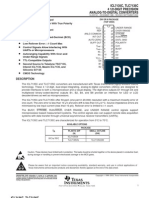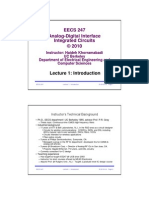LF155
LF155
Uploaded by
Brzata PticaCopyright:
Available Formats
LF155
LF155
Uploaded by
Brzata PticaCopyright
Available Formats
Share this document
Did you find this document useful?
Is this content inappropriate?
Copyright:
Available Formats
LF155
LF155
Uploaded by
Brzata PticaCopyright:
Available Formats
LF155/LF156/LF355/LF356/LF357 JFET Input Operational Amplifiers
May 2000
LF155/LF156/LF355/LF356/LF357 JFET Input Operational Amplifiers
General Description
These are the first monolithic JFET input operational amplifiers to incorporate well matched, high voltage JFETs on the same chip with standard bipolar transistors (BI-FET Technology). These amplifiers feature low input bias and offset currents/low offset voltage and offset voltage drift, coupled with offset adjust which does not degrade drift or common-mode rejection. The devices are also designed for high slew rate, wide bandwidth, extremely fast settling time, low voltage and current noise and a low 1/f noise corner. n n n n Wideband, low noise, low drift amplifiers Logarithmic amplifiers Photocell amplifiers Sample and Hold circuits
Features
Advantages n Replace expensive hybrid and module FET op amps n Rugged JFETs allow blow-out free handling compared with MOSFET input devices n Excellent for low noise applications using either high or low source impedance very low 1/f corner n Offset adjust does not degrade drift or common-mode rejection as in most monolithic amplifiers n New output stage allows use of large capacitive loads (5,000 pF) without stability problems n Internal compensation and large differential input voltage capability
Common Features n Low input bias current: 30pA n Low Input Offset Current: 3pA n High input impedance: 1012 n Low input noise current: n High common-mode rejection ratio: n Large dc voltage gain: 106 dB
100 dB
Uncommon Features
LF155/ LF355
j
LF156/ LF356 1.5
LF357 (AV =5) 1.5
Units s
Extremely fast settling time to 0.01% Fast slew rate Wide gain bandwidth Low input noise voltage
j j j
5 2.5 20
12 5 12
50 20 12
V/s MHz
Applications
n Precision high speed integrators n Fast D/A and A/D converters n High impedance buffers
Simplified Schematic
DS005646-1
*3 pF in LF357 series.
BI-FET, BI-FET II are trademarks of National Semiconductor Corporation.
2001 National Semiconductor Corporation
DS005646
www.national.com
LF155/LF156/LF355/LF356/LF357
Absolute Maximum Ratings (Note 1)
If Military/Aerospace specified devices are required, contact the National Semiconductor Sales Office/Distributors for availability and specifications. LF155/6 LF356B LF355/6/7 22V 22V 18V Supply Voltage 40V 40V 30V Differential Input Voltage 20V 20V 16V Input Voltage Range (Note 2) Output Short Circuit Duration Continuous Continuous Continuous TJMAX H-Package 150C 115C 115C N-Package 100C 100C M-Package 100C 100C Power Dissipation at TA = 25C (Notes 1, 8) H-Package (Still Air) 560 mW 400 mW 400 mW H-Package (400 LF/Min Air Flow) 1200 mW 1000 mW 1000 mW N-Package 670 mW 670 mW M-Package 380 mW 380 mW Thermal Resistance (Typical) JA H-Package (Still Air) 160C/W 160C/W 160C/W H-Package (400 LF/Min Air Flow) 65C/W 65C/W 65C/W N-Package 130C/W 130C/W M-Package 195C/W 195C/W (Typical) JC H-Package 23C/W 23C/W 23C/W Storage Temperature Range 65C to +150C 65C to +150C 65C to +150C Soldering Information (Lead Temp.) Metal Can Package Soldering (10 sec.) 300C 300C 300C Dual-In-Line Package Soldering (10 sec.) 260C 260C 260C Small Outline Package Vapor Phase (60 sec.) 215C 215C Infrared (15 sec.) 220C 220C See AN-450 Surface Mounting Methods and Their Effect on Product Reliability for other methods of soldering surface mount devices. ESD tolerance (100 pF discharged through 1.5 k) 1000V 1000V 1000V
DC Electrical Characteristics
(Note 3) Symbol VOS VOS/T TC/VOS IOS IB RIN Parameter Input Offset Voltage Average TC of Input Offset Voltage Change in Average TC with VOS Adjust Input Offset Current Input Bias Current Input Resistance Conditions RS =50, TA =25C Over Temperature RS =50 RS =50, (Note 4) TJ =25C, (Notes 3, 5) TJTHIGH TJ =25C, (Notes 3, 5) TJTHIGH TJ =25C 1012 30 5 0.5 3 20 20 100 50 1012 30 LF155/6 Min Typ 3 Max Min 5 7 5 0.5 3 20 1 100 5 1012 30 LF356B Typ 3 Max Min 5 6.5 5 0.5 3 50 2 200 8 LF355/6/7 Typ 3 Max 10 13 Units mV mV V/C V/C per mV pA nA pA nA
www.national.com
LF155/LF156/LF355/LF356/LF357
DC Electrical Characteristics
(Note 3) Symbol AVOL Parameter Large Signal Voltage Gain Output Voltage Swing Input Common-Mode Voltage Range Common-Mode Rejection Ratio Supply Voltage Rejection Ratio (Note 6)
(Continued)
Conditions VS = 15V, TA =25C VO = 10V, RL =2k Over Temperature
LF155/6 Min 50 25 Typ 200 Max Min 50 25
LF356B Typ 200 Max Min 25 15
LF355/6/7 Typ 200 Max
Units V/mV V/mV
VO VCM CMRR PSRR
VS = 15V, RL =10k VS = 15V, RL =2k VS = 15V
12 10 11
85 85
13 12
+15.1 12 100 100
12 10 11
85 85
13 12 15.1
12 100 100
12 10
+10 80 80
13 12
+15.1 12 100 100
V V V V dB dB
DC Electrical Characteristics
TA = TJ = 25C, VS = 15V Parameter Supply Current LF155 Typ 2 Max 4 Typ 2 LF355 Max 4 LF156/356B Typ 5 Max 7 Typ 5 LF356 Max 10 Typ 5 LF357 Max 10 Units mA
AC Electrical Characteristics
TA = TJ = 25C, VS = 15V LF155/355 Symbol SR GBW ts en Parameter Slew Rate Gain Bandwidth Product Settling Time to 0.01% Equivalent Input Noise Voltage Equivalent Input Current Noise Input Capacitance (Note 7) RS =100 f=100 Hz f=1000 Hz in CIN f=100 Hz f=1000 Hz 25 20 0.01 0.01 3 15 12 0.01 0.01 3 15 12 0.01 0.01 3 pF Conditions Typ LF155/6: AV =1, LF357: AV =5 2.5 4 5 1.5 5 Min 7.5 LF156/356B LF156/356/ LF356B Typ 12 50 20 1.5 LF357 Units Typ V/s V/s MHz s
Notes for Electrical Characteristics
Note 1: The maximum power dissipation for these devices must be derated at elevated temperatures and is dictated by TJMAX, JA, and the ambient temperature, TA. The maximum available power dissipation at any temperature is Pd =(TJMAXTA)/JA or the 25C PdMAX, whichever is less. Note 2: Unless otherwise specified the absolute maximum negative input voltage is equal to the negative power supply voltage. Note 3: Unless otherwise stated, these test conditions apply:
LF155/156 Supply Voltage, VS TA THIGH
and VOS, IB and IOS are measured at VCM =0.
LF356B
LF355/6/7 VS = 15V 0CTA+70C +70C
15VVS 20V
55CTA+125C +125C
15VVS 20V
0CTA+70C +70C
Note 4: The Temperature Coefficient of the adjusted input offset voltage changes only a small amount (0.5V/C typically) for each mV of adjustment from its original unadjusted value. Common-mode rejection and open loop voltage gain are also unaffected by offset adjustment.
www.national.com
LF155/LF156/LF355/LF356/LF357
Notes for Electrical Characteristics
(Continued)
Note 5: The input bias currents are junction leakage currents which approximately double for every 10C increase in the junction temperature, TJ. Due to limited production test time, the input bias currents measured are correlated to junction temperature. In normal operation the junction temperature rises above the ambient temperature as a result of internal power dissipation, Pd. TJ =TA+JA Pd where JA is the thermal resistance from junction to ambient. Use of a heat sink is recommended if input bias current is to be kept to a minimum. Note 6: Supply Voltage Rejection is measured for both supply magnitudes increasing or decreasing simultaneously, in accordance with common practice. Note 7: Settling time is defined here, for a unity gain inverter connection using 2 k resistors for the LF155/6. It is the time required for the error voltage (the voltage at the inverting input pin on the amplifier) to settle to within 0.01% of its final value from the time a 10V step input is applied to the inverter. For the LF357, AV =5, the feedback resistor from output to input is 2 k and the output step is 10V (See Settling Time Test Circuit). Note 8: Max. Power Dissipation is defined by the package characteristics. Operating the part near the Max. Power Dissipation may cause the part to operate outside guaranteed limits.
Typical DC Performance Characteristics
specified. Input Bias Current
Curves are for LF155 and LF156 unless otherwise
Input Bias Current
DS005646-37
DS005646-38
Input Bias Current
Voltage Swing
DS005646-39
DS005646-40
www.national.com
LF155/LF156/LF355/LF356/LF357
Typical DC Performance Characteristics
specified. (Continued) Supply Current
Curves are for LF155 and LF156 unless otherwise
Supply Current
DS005646-41
DS005646-42
Negative Current Limit
Positive Current Limit
DS005646-43
DS005646-44
Positive Common-Mode Input Voltage Limit
Negative Common-Mode Input Voltage Limit
DS005646-45 DS005646-46
www.national.com
LF155/LF156/LF355/LF356/LF357
Typical DC Performance Characteristics
specified. (Continued) Open Loop Voltage Gain
Curves are for LF155 and LF156 unless otherwise
Output Voltage Swing
DS005646-47
DS005646-48
Typical AC Performance Characteristics
Gain Bandwidth Gain Bandwidth
DS005646-49
DS005646-50
Normalized Slew Rate
Output Impedance
DS005646-51
DS005646-52
www.national.com
LF155/LF156/LF355/LF356/LF357
Typical AC Performance Characteristics
Output Impedance
(Continued)
LF155 Small Signal Pulse Response, AV = +1
DS005646-5
DS005646-53
LF156 Small Signal Pulse Response, AV = +1
LF155 Large Signal Pulse Response, AV = +1
DS005646-6
DS005646-8
LF156 Large Signal Puls Response, AV = +1
Inverter Settling Time
DS005646-9
DS005646-55
www.national.com
LF155/LF156/LF355/LF356/LF357
Typical AC Performance Characteristics
Inverter Settling Time
(Continued)
Open Loop Frequency Response
DS005646-56
DS005646-57
Bode Plot
Bode Plot
DS005646-58
DS005646-59
Bode Plot
Common-Mode Rejection Ratio
DS005646-60
DS005646-61
www.national.com
LF155/LF156/LF355/LF356/LF357
Typical AC Performance Characteristics
Power Supply Rejection Ratio
(Continued)
Power Supply Rejection Ratio
DS005646-62
DS005646-63
Undistorted Output Voltage Swing
Equivalent Input Noise Voltage
DS005646-64 DS005646-65
Equivalent Input Noise Voltage (Expanded Scale)
DS005646-66
www.national.com
LF155/LF156/LF355/LF356/LF357
Detailed Schematic
DS005646-13
*C = 3 pF in LF357 series.
Connection Diagrams
(Top Views)
Metal Can Package (H) Dual-In-Line Package (M and N)
DS005646-14
*Available per JM38510/11401 or JM38510/11402
Order Number LF155H, LF156H, LF356BH, LF356H, or LF357H See NS Package Number H08C
DS005646-29
Order Number LF356M, LF356MX, LF355N, or LF356N See NS Package Number M08A or N08E
www.national.com
10
LF155/LF156/LF355/LF356/LF357
Application Hints
These are op amps with JFET input devices. These JFETs have large reverse breakdown voltages from gate to source and drain eliminating the need for clamps across the inputs. Therefore large differential input voltages can easily be accommodated without a large increase in input current. The maximum differential input voltage is independent of the supply voltages. However, neither of the input voltages should be allowed to exceed the negative supply as this will cause large currents to flow which can result in a destroyed unit. Exceeding the negative common-mode limit on either input will force the output to a high state, potentially causing a reversal of phase to the output. Exceeding the negative common-mode limit on both inputs will force the amplifier output to a high state. In neither case does a latch occur since raising the input back within the common-mode range again puts the input stage and thus the amplifier in a normal operating mode. Exceeding the positive common-mode limit on a single input will not change the phase of the output however, if both inputs exceed the limit, the output of the amplifier will be forced to a high state. These amplifiers will operate with the common-mode input voltage equal to the positive supply. In fact, the common-mode voltage can exceed the positive supply by approximately 100 mV independent of supply voltage and over the full operating temperature range. The positive supply can therefore be used as a reference on an input as, for example, in a supply current monitor and/or limiter. Precautions should be taken to ensure that the power supply for the integrated circuit never becomes reversed in polarity or that the unit is not inadvertently installed backwards in a socket as an unlimited current surge through the resulting forward diode within the IC could cause fusing of the internal conductors and result in a destroyed unit. All of the bias currents in these amplifiers are set by FET current sources. The drain currents for the amplifiers are therefore essentially independent of supply voltage. As with most amplifiers, care should be taken with lead dress, component placement and supply decoupling in order to ensure stability. For example, resistors from the output to an input should be placed with the body close to the input to minimize pickup and maximize the frequency of the feedback pole by minimizing the capacitance from the input to ground. A feedback pole is created when the feedback around any amplifier is resistive. The parallel resistance and capacitance from the input of the device (usually the inverting input) to ac ground set the frequency of the pole. In many instances the frequency of this pole is much greater than the expected 3 dB frequency of the closed loop gain and consequently there is negligible effect on stability margin. However, if the feedback pole is less than approximately six times the expected 3 dB frequency a lead capacitor should be placed from the output to the input of the op amp. The value of the added capacitor should be such that the RC time constant of this capacitor and the resistance it parallels is greater than or equal to the original feedback pole time constant.
Typical Circuit Connections
VOS Adjustment
DS005646-67
VOS is adjusted with a 25k potentiometer The potentiometer wiper is connected to V+ For potentiometers with temperature coefficient of 100 ppm/C or less the additional drift with adjust is 0.5 V/C/mV of adjustment Typical overall drift: 5 V/C (0.5 V/C/mV of adj.)
11
www.national.com
LF155/LF156/LF355/LF356/LF357
Typical Circuit Connections
(Continued) Driving Capacitive Loads
DS005646-68
* LF155/6 R = 5k
LF357 R=1.25k Due to a unique output stage design, these amplifiers have the ability to drive large capacitive loads and still maintain stability. CL(MAX) . 0.01 F. Overshoot 20% Settling time (ts) . 5 s
LF357. A Large Power BW Amplifier
DS005646-15
For distortion 1% and a 20 Vp-p VOUT swing, power bandwidth is: 500 kHz.
Typical Applications
Settling Time Test Circuit
DS005646-16
Settling time is tested with the LF155/6 connected as unity gain inverter and LF357 connected for AV = 5 FET used to isolate the probe capacitance Output = 10V step AV = 5 for LF357
www.national.com
12
LF155/LF156/LF355/LF356/LF357
Typical Applications
(Continued)
Large Signal Inverter Output, VOUT (from Settling Time Circuit) LF355 LF356 LF357
DS005646-17
DS005646-18
DS005646-19
Low Drift Adjustable Voltage Reference
DS005646-20
VOUT/T= 0.002%/C All resistors and potentiometers should be wire-wound P1: drift adjust P2: VOUT adjust Use LF155 for
j Low IB j Low drift j Low supply current
13
www.national.com
LF155/LF156/LF355/LF356/LF357
Typical Applications
(Continued) Fast Logarithmic Converter
DS005646-21
Dynamic range: 100 A Ii 1 mA (5 decades), |VO|=1V/decade Transient response: 3 s for Ii = 1 decade C1, C2, R2, R3: added dynamic compensation VOS adjust the LF156 to minimize quiescent error RT: Tel Labs type Q81 + 0.3%/C
Precision Current Monitor
DS005646-31
VO =5 R1/R2 (V/mA of IS) R1, R2, R3: 0.1% resistors Use LF155 for
j Common-mode range to supply range j Low IB j Low VOS j Low Supply Current
www.national.com
14
LF155/LF156/LF355/LF356/LF357
Typical Applications
(Continued)
8-Bit D/A Converter with Symmetrical Offset Binary Operation
DS005646-32
R1, R2 should be matched within 0.05% Full-scale response time: 3 s EO +9.920 +0.040 0.040 9.920 B1 B2 B3 B4 B5 B6 B7 B8 1 1 0 0 1 0 1 0 1 0 1 0 1 0 1 0 1 0 1 0 1 0 1 0 1 0 1 0 1 0 1 0 Comments Positive Full-Scale (+) Zero-Scale () Zero-Scale Negative Full-Scale
Wide BW Low Noise, Low Drift Amplifier
DS005646-70
Parasitic input capacitance C1 . (3 pF for LF155, LF156 and LF357 plus any additional layout capacitance) interacts with feedback elements and creates undesirable high frequency pole. To compensate add C2 such that: R2 C2 . R1 C1.
15
www.national.com
LF155/LF156/LF355/LF356/LF357
Typical Applications
(Continued) Boosting the LF156 with a Current Amplifier
DS005646-73
IOUT(MAX).150 mA (will drive RL 100)
No additional phase shift added by the current amplifier
3 Decades VCO
DS005646-24
R1, R4 matched. Linearity 0.1% over 2 decades.
www.national.com
16
LF155/LF156/LF355/LF356/LF357
Typical Applications
(Continued) Isolating Large Capacitive Loads
DS005646-22
Overshoot 6% ts 10 s When driving large CL, the VOUT slew rate determined by CL and IOUT(MAX):
Low Drift Peak Detector
DS005646-23
By adding D1 and Rf, VD1 =0 during hold mode. Leakage of D2 provided by feedback path through Rf. Leakage of circuit is essentially Ib (LF155, LF156) plus capacitor leakage of Cp. Diode D3 clamps VOUT (A1) to VINVD3 to improve speed and to limit reverse bias of D2. Maximum input frequency should be << 12RfCD2 where CD2 is the shunt capacitance of D2.
17
www.national.com
LF155/LF156/LF355/LF356/LF357
Typical Applications
(Continued) Non-Inverting Unity Gain Operation for LF157
DS005646-75
Inverting Unity Gain for LF157
DS005646-25
www.national.com
18
LF155/LF156/LF355/LF356/LF357
Typical Applications
(Continued) High Impedance, Low Drift Instrumentation Amplifier
DS005646-26
System VOS adjusted via A2 VOS adjust Trim R3 to boost up CMRR to 120 dB. Instrumentation amplifier resistor array recommended for best accuracy and lowest drift
19
www.national.com
LF155/LF156/LF355/LF356/LF357
Typical Applications
(Continued) Fast Sample and Hold
DS005646-33
Both amplifiers (A1, A2) have feedback loops individually closed with stable responses (overshoot negligible) Acquisition time TA, estimated by:
LF156 develops full Sr output capability for VIN1V Addition of SW2 improves accuracy by putting the voltage drop across SW1 inside the feedback loop Overall accuracy of system determined by the accuracy of both amplifiers, A1 and A2
www.national.com
20
LF155/LF156/LF355/LF356/LF357
Typical Applications
(Continued) High Accuracy Sample and Hold
DS005646-27
By closing the loop through A2, the VOUT accuracy will be determined uniquely by A1. No VOS adjust required for A2. TA can be estimated by same considerations as previously but, because of the added propagation delay in the feedback loop (A2) the overshoot is not negligible. Overall system slower than fast sample and hold R1, CC: additional compensation Use LF156 for
j Fast settling time j Low VOS
High Q Band Pass Filter
DS005646-28
By adding positive feedback (R2) Q increases to 40 fBP =100 kHz
Clean layout recommended Response to a 1 Vp-p tone burst: 300 s
21
www.national.com
LF155/LF156/LF355/LF356/LF357
Typical Applications
(Continued) High Q Notch Filter
DS005646-34
2R1 = R = 10 M 2C = C1 = 300 pF Capacitors should be matched to obtain high Q fNOTCH = 120 Hz, notch = 55 dB, Q > 100 Use LF155 for
j Low IB j Low supply current
www.national.com
22
LF155/LF156/LF355/LF356/LF357
Physical Dimensions
inches (millimeters) unless otherwise noted
Metal Can Package (H) Order Number LF155H, LF156H, LF356BH, LF356H or LF357H NS Package Number H08C
Small Outline Package (M) Order Number LF356M or LF356MX NS Package Number M08A
23
www.national.com
LF155/LF156/LF355/LF356/LF357 JFET Input Operational Amplifiers
Physical Dimensions
inches (millimeters) unless otherwise noted (Continued)
Molded Dual-In-Line Package (N) Order Number LF356N NS Package Number N08E
LIFE SUPPORT POLICY NATIONALS PRODUCTS ARE NOT AUTHORIZED FOR USE AS CRITICAL COMPONENTS IN LIFE SUPPORT DEVICES OR SYSTEMS WITHOUT THE EXPRESS WRITTEN APPROVAL OF THE PRESIDENT AND GENERAL COUNSEL OF NATIONAL SEMICONDUCTOR CORPORATION. As used herein: 1. Life support devices or systems are devices or systems which, (a) are intended for surgical implant into the body, or (b) support or sustain life, and whose failure to perform when properly used in accordance with instructions for use provided in the labeling, can be reasonably expected to result in a significant injury to the user.
National Semiconductor Corporation Americas Tel: 1-800-272-9959 Fax: 1-800-737-7018 Email: support@nsc.com www.national.com National Semiconductor Europe Fax: +49 (0) 180-530 85 86 Email: europe.support@nsc.com Deutsch Tel: +49 (0) 69 9508 6208 English Tel: +44 (0) 870 24 0 2171 Franais Tel: +33 (0) 1 41 91 8790
2. A critical component is any component of a life support device or system whose failure to perform can be reasonably expected to cause the failure of the life support device or system, or to affect its safety or effectiveness.
National Semiconductor Asia Pacific Customer Response Group Tel: 65-2544466 Fax: 65-2504466 Email: ap.support@nsc.com
National Semiconductor Japan Ltd. Tel: 81-3-5639-7560 Fax: 81-3-5639-7507
National does not assume any responsibility for use of any circuitry described, no circuit patent licenses are implied and National reserves the right at any time without notice to change said circuitry and specifications.
You might also like
- Manual - IR Nirvana Troubleshooting GuideDocument63 pagesManual - IR Nirvana Troubleshooting GuideKurserg92% (52)
- A Sudhakar - Shyammohan S Palli - Network Analysis - JNTU (K) - McGraw-Hill Education (2015)Document87 pagesA Sudhakar - Shyammohan S Palli - Network Analysis - JNTU (K) - McGraw-Hill Education (2015)Yoga Dharshini100% (1)
- A Guide to Electronic Maintenance and RepairsFrom EverandA Guide to Electronic Maintenance and RepairsRating: 4.5 out of 5 stars4.5/5 (7)
- Series and Parallel ResonanceDocument15 pagesSeries and Parallel ResonanceEuric CalityNo ratings yet
- LM356Document25 pagesLM356Wilfredo Paniagua OrellanaNo ratings yet
- LF347n PDFDocument13 pagesLF347n PDFDiego PeñuelaNo ratings yet
- Datasheet LF412CNDocument14 pagesDatasheet LF412CNJose Fernando Perdomo BolañosNo ratings yet
- LF347BNDocument15 pagesLF347BNDavid Emmanuel Contreras MadrigalNo ratings yet
- Opamp - Lf155 Lf156 Lf157 - NatsemDocument19 pagesOpamp - Lf155 Lf156 Lf157 - NatsemLudwig SchmidtNo ratings yet
- TL082Document14 pagesTL082radioscribdNo ratings yet
- TL082 EqualizerDocument16 pagesTL082 EqualizerMecabot DzibNo ratings yet
- DatasheetDocument10 pagesDatasheetCristina Nae0% (1)
- LM318HDocument19 pagesLM318HAlberto MarsicoNo ratings yet
- Features Descriptio: Applicatio S UDocument20 pagesFeatures Descriptio: Applicatio S UMikołajNo ratings yet
- Datasheet 1Document18 pagesDatasheet 1shashwatthakurNo ratings yet
- LF442Document14 pagesLF442atavachronNo ratings yet
- Tl082cp Datasheet de National Semiconductor para Sustituir Ci de Etapa Pre Amplificador Bunker Mx2400 2Document12 pagesTl082cp Datasheet de National Semiconductor para Sustituir Ci de Etapa Pre Amplificador Bunker Mx2400 2Jess AJNo ratings yet
- LM3478 High Efficiency Low-Side N-Channel Controller For Switching RegulatorDocument22 pagesLM3478 High Efficiency Low-Side N-Channel Controller For Switching RegulatorVinoth Kumar RajendranNo ratings yet
- lf347 NDocument21 pageslf347 NEda UluNo ratings yet
- OpAmp - LF451Document8 pagesOpAmp - LF451Ludwig SchmidtNo ratings yet
- LM2577 PDFDocument27 pagesLM2577 PDFAtieyChentaQasehNo ratings yet
- tl082 Op Amp DatasheetDocument23 pagestl082 Op Amp DatasheetnurburgNo ratings yet
- tl082cp DatasheetDocument15 pagestl082cp DatasheetHeriberto Flores AmpieNo ratings yet
- Lm2596 Simple Switcher Power Converter 150 KHZ 3A Step-Down Voltage RegulatorDocument29 pagesLm2596 Simple Switcher Power Converter 150 KHZ 3A Step-Down Voltage RegulatorJuliano GriguloNo ratings yet
- High Efficiency Low-Side N-Channel Controller For Switching RegulatorsDocument33 pagesHigh Efficiency Low-Side N-Channel Controller For Switching Regulatorssoft4gsmNo ratings yet
- LM311Document23 pagesLM311Brzata PticaNo ratings yet
- LF351NDocument11 pagesLF351NAndres CampoNo ratings yet
- LM2596S ADJ Power Converter RegulatorDocument31 pagesLM2596S ADJ Power Converter RegulatorCadet RaparivoNo ratings yet
- LF353Document13 pagesLF353cromus_9000No ratings yet
- Lm2577 Adj MDCDocument27 pagesLm2577 Adj MDCroozbehxoxNo ratings yet
- LF444 Quad Low Power JFET Input Operational Amplifier: General Description FeaturesDocument11 pagesLF444 Quad Low Power JFET Input Operational Amplifier: General Description FeaturesJohn PachecoNo ratings yet
- LM101ADocument20 pagesLM101AAna MelendezNo ratings yet
- LM340Document17 pagesLM340Lucas Diego Rodrigues FerreiraNo ratings yet
- LM338KDocument14 pagesLM338KBernardo Gomez JuarezNo ratings yet
- Datasheet LF 353Document14 pagesDatasheet LF 353Anggridho MeilandanuNo ratings yet
- LF351Document10 pagesLF351Benjamin JonesNo ratings yet
- LM 2587 DatasheetDocument26 pagesLM 2587 DatasheetAnonymous vKD3FG6RkNo ratings yet
- LM340/LM78XX Series 3-Terminal Positive Regulators: Literature Number: SNOSBT0HDocument19 pagesLM340/LM78XX Series 3-Terminal Positive Regulators: Literature Number: SNOSBT0HDaniel Quesada SolísNo ratings yet
- Ca3140 ADocument23 pagesCa3140 AvjchandrarNo ratings yet
- LM340K 12 7812P+Document18 pagesLM340K 12 7812P+abrap_delNo ratings yet
- LF357HDocument23 pagesLF357HVerjemgordatNo ratings yet
- LF442CNDocument13 pagesLF442CNFSNo ratings yet
- CMOS 1.8 V to 5.5 V, 2.5 Ω SPDT Switch/2:1 Mux in Tiny SC70 Package ADG779Document12 pagesCMOS 1.8 V to 5.5 V, 2.5 Ω SPDT Switch/2:1 Mux in Tiny SC70 Package ADG779Fer TgNo ratings yet
- Datasheet lf356 PDFDocument23 pagesDatasheet lf356 PDFAlberto Chica CardenasNo ratings yet
- Reference Guide To Useful Electronic Circuits And Circuit Design Techniques - Part 2From EverandReference Guide To Useful Electronic Circuits And Circuit Design Techniques - Part 2No ratings yet
- Reference Guide To Useful Electronic Circuits And Circuit Design Techniques - Part 1From EverandReference Guide To Useful Electronic Circuits And Circuit Design Techniques - Part 1Rating: 2.5 out of 5 stars2.5/5 (3)
- A Guide to Vintage Audio Equipment for the Hobbyist and AudiophileFrom EverandA Guide to Vintage Audio Equipment for the Hobbyist and AudiophileNo ratings yet
- Analog Dialogue Volume 46, Number 1: Analog Dialogue, #5From EverandAnalog Dialogue Volume 46, Number 1: Analog Dialogue, #5Rating: 5 out of 5 stars5/5 (1)
- Analog Dialogue, Volume 48, Number 1: Analog Dialogue, #13From EverandAnalog Dialogue, Volume 48, Number 1: Analog Dialogue, #13Rating: 4 out of 5 stars4/5 (1)
- Easy(er) Electrical Principles for General Class Ham License (2015-2019)From EverandEasy(er) Electrical Principles for General Class Ham License (2015-2019)Rating: 5 out of 5 stars5/5 (1)
- MPD May 2012Document120 pagesMPD May 2012Brzata PticaNo ratings yet
- Ham Radio - David HarrisDocument35 pagesHam Radio - David HarrisBrzata Ptica0% (1)
- MosfetDocument27 pagesMosfetBrzata Ptica100% (1)
- Multi ChannelDocument6 pagesMulti ChannelBrzata PticaNo ratings yet
- HWBOOKDocument441 pagesHWBOOKrevanthseguNo ratings yet
- Hef 4071 BDocument3 pagesHef 4071 BBrzata PticaNo ratings yet
- Hef 4049 BDocument4 pagesHef 4049 BBrzata PticaNo ratings yet
- lm741 PDFDocument7 pageslm741 PDFDarilho Batista IgnacioNo ratings yet
- Best Guitar Circuit Op Amp.Document20 pagesBest Guitar Circuit Op Amp.scrible23No ratings yet
- LT1144Document8 pagesLT1144Brzata PticaNo ratings yet
- tl084 PDFDocument30 pagestl084 PDFKakaroto Maximo Decimo MeridioNo ratings yet
- LM3914Document19 pagesLM3914Brzata PticaNo ratings yet
- LM392Document6 pagesLM392Brzata PticaNo ratings yet
- LM311Document23 pagesLM311Brzata PticaNo ratings yet
- Tda 1591Document20 pagesTda 1591Brzata PticaNo ratings yet
- Physics 229 Lab 9: Capacitors: GoalsDocument6 pagesPhysics 229 Lab 9: Capacitors: GoalsThomas PanNo ratings yet
- JEE Main 2022 Revision Notes On Electrostatics - Free PDF DownloadDocument12 pagesJEE Main 2022 Revision Notes On Electrostatics - Free PDF Downloadba liNo ratings yet
- Plastic Silicon Rectifiers: FeaturesDocument2 pagesPlastic Silicon Rectifiers: FeaturestheserviceNo ratings yet
- RTTB Sample ConnectionDocument31 pagesRTTB Sample Connectionhogorep331No ratings yet
- FKGS-T Manual (W)Document12 pagesFKGS-T Manual (W)gir_bnNo ratings yet
- HIP4080A, 80V High Frequency H-Bridge Driver: Application Note December 11, 2007 AN9404.3Document13 pagesHIP4080A, 80V High Frequency H-Bridge Driver: Application Note December 11, 2007 AN9404.3Natalia González RoggetNo ratings yet
- Correct Ans & Past Paper EE MCQSDocument136 pagesCorrect Ans & Past Paper EE MCQSAhmad USmanNo ratings yet
- JT3D (TF33) S3P3Document58 pagesJT3D (TF33) S3P3junmech-1No ratings yet
- FiltersDocument3 pagesFilterspraneeth kuchimanchiNo ratings yet
- Mock Test Code-CDocument19 pagesMock Test Code-CKomal VermaNo ratings yet
- T.L.E 7 and 8 Week 1Document11 pagesT.L.E 7 and 8 Week 1Eleonor Distrajo100% (2)
- Btech Ee 3 Sem Electrical Measurements and Instrumentation Kee302 2022Document2 pagesBtech Ee 3 Sem Electrical Measurements and Instrumentation Kee302 2022Priyanshu SuryavanshiNo ratings yet
- ICL7135Document16 pagesICL7135JIGNESHNo ratings yet
- Power SupplyDocument21 pagesPower SupplyAkashi SeijuroNo ratings yet
- 60-03 CPR04 ManualDocument74 pages60-03 CPR04 ManualsoundrisrinivasanNo ratings yet
- Berkley LectureDocument25 pagesBerkley LectureSanjay Subba RaoNo ratings yet
- Capacitors 2Document4 pagesCapacitors 2Tran Phuong LinhNo ratings yet
- 04 - Electromagnetic Waves (Griffiths - Ch9)Document95 pages04 - Electromagnetic Waves (Griffiths - Ch9)Shobit JainNo ratings yet
- Medd Komite SortertDocument33 pagesMedd Komite SortertSergio LungrinNo ratings yet
- Spellman HIGH VOLTAGE REFERENCE MANUALDocument192 pagesSpellman HIGH VOLTAGE REFERENCE MANUALNikita Kaplenko100% (1)
- Renr5807renr5807 01 Sis PDFDocument2 pagesRenr5807renr5807 01 Sis PDFLeonardo Romero JimenezNo ratings yet
- Power Factor Management Scheme Is Best Described Here.Document42 pagesPower Factor Management Scheme Is Best Described Here.Sunil SinghNo ratings yet
- University of The Philippines College of ScienceDocument13 pagesUniversity of The Philippines College of ScienceJon Daniel CampbellNo ratings yet
- DatasheetDocument20 pagesDatasheetyunusemrekaplanNo ratings yet
- Chapter 8: Noise and Noise Reduction TechniquesDocument16 pagesChapter 8: Noise and Noise Reduction Techniquesrockrockyrocker123No ratings yet
- Physics Sample Papers 2022-23Document245 pagesPhysics Sample Papers 2022-23AsherNo ratings yet


